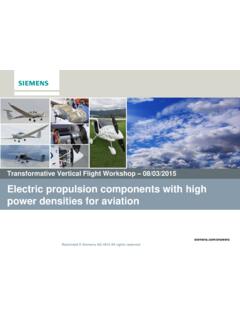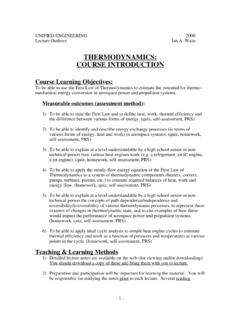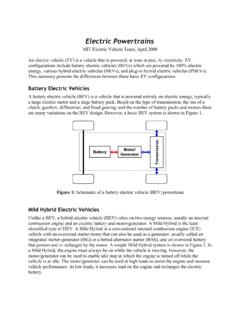Transcription of Space Nuclear Power and Propulsion (SNPP)
1 Space Nuclear Power and Propulsion (SNPP)STMD Space Nuclear Technologies Portfolio, September 1, 2020Dr. Anthony Calomino | STMD Nuclear Technologies Portfolio ManagerThe NASA STMD Space Nuclear Technology portfolio within the Technology Demonstration Mission program focuses on advancing Nuclear fission technology and system capabilities to meet Space exploration missions needs Design, build, and demonstrate a Space -rated fission surface Power system that enables a sustained lunar presence and is directly extensible to future planetary surface missions Advance a deep- Space , Nuclear - Propulsion capability through the maturation of key, high-risk technologies that lead to the design, build, and demonstration of a human rated Propulsion system Establish collaborative.
2 Working relationships with other government agencies and organizations that share common, synergistic technology needs such as the DoD and DoE Catalyze industry and academic interest and support to enable broad spectrum of innovative and economic technology approaches and solutionsSpace Nuclear Technology Overview 2 Space Nuclear Technology (SNT) Portfolio ProjectsTHESPACENUCLEARTECHNOLOGYPORTFOL IOWITHINMSFC-LEDTDMPROGRAMCONSISTSOFTWOM AJORFISSIONTECHNOLOGYINVESTMENTAREASF ission Surface Power (FSP)Solar independent, continuous Power production Enable sustained, long-duration lunar operations Demonstrate operational extensibility to Mars missionSpace Nuclear Propulsion (SNP)Enable opposition-class, short-duration Mars mission Focus for NTP is on fuel and reactor technology maturation Identify NEP subsystem capability gaps and needs Advance critical CFM technologies needed for SNP Prioritize lunar surface Power while continuing to advance Nuclear Propulsion capabilities to support future human missions to Mars3 Space Nuclear Technology ProjectsThe Agency is currently engaged in advancing technologies for both Propulsion and Power fission systems with DOE support4 Space Nuclear Propulsion (Mike Kynard, PrjMngr, MSFC)
3 High temperature, 500 MW thermal reactor drives high Ispengine Support for a common NASA/DOE/DOD fuel production capability Pursuing a DOE industry solicitation for reactor designs Fission Surface Power (Todd Tofil, PrjMngr, GRC) Low weight reactor with 10 kW dynamic Power conversion system Requires near term reactor fuels and materials development Open design and trade Space will define what the government needs, design and test qualification identified by industryNTP vehicle conceptGovernment Reference DesignInvestment is focused on two Projects within the Technology Demonstration Program managed by Marshall Space Flight CenterAgency reference configuration for Mars architecture is NEP5 SNPP Working Group provides a forum to collaborate on Nuclear research and development areas of mutual benefit and reinvigorate US commercial Nuclear industryCurrent NASA/DOE SNPP collaborations fall under an existing 2016 MOU that establishes Nuclear safety framework including indemnificationPotential opportunities for collaborative research and development with commercial partners that could benefit the Space and
4 Terrestrial Nuclear systems include: Reactor fuel and materials research and development Additive/advanced manufacturing methods and processes Test and demonstration infrastructure capabilitiesNASA/DOE MOU Energy-related Civil Space ActivitiesAdvanced RPSF ission Surface PowerKick-off at the Mars 2020 Perseverance launch, MOU supersedes a 1992 agreement and establishes interagency Working Groups on Strategic and Innovative Collaborations, Space Nuclear Power and Propulsion (SNPP), and Crewed Lunar Surface EnvironmentsFission Surface Power (FSP)Fission Surface Power (FSP) The United States a sustainable human presence on the Moon by 2028, and chart a future path for Mars House Fact Sheet, 26 Mar 2019 NASA and DOE are collaborating on the development of a 10 kWe-class fission Power system for a flight demonstration to the Moon by 2027, with extensibility to human Mars Government Reference DesignFission surface Power is the Agency s top Nuclear priority Enabling capability for lunar sustainable presence and crewed Mars exploration Provides a near-term opportunity for fabrication, testing.
5 And flight of a Space fission system Will serve as a pathfinder for launching and operating other Space fission systems DOE identified moderated HALEU FSP reactors and recently released an RFI for Industry Designs 7 FSP Integration StoryMars Surface Power Needs Nominal 10 kWepower source meets current Mars surface Power needs Lunar operational needs and performance metrics feed forward to lunar demonstrationLunar Surface Sustainability system design to provide dissimilar redundant Power for sustained operation Concept of operation includes Power management system , Power cable, cable cart, and avionics Lunar Surface Fission Power Demonstration Design, fabricate and qualify a launch ready 10 kWeFSP flight unit by late 2020 s Flight qualified hardware needed for reactor, Power conversion and heat rejection8 DOE reactor study completed in March 2020 identified LEU reactor solutions in same mass class as HEU system These are moderated reactors with lower technology maturity but potential alignment with industryFission Surface Power Lunar Demonstration9 Fission Surface Power system Design Power : 10kWe Life: 10 year design life Modularity: Multi-unit interconnectivity to accommodate higher Power Distribution: 1km cable cart + conditioning box Radiation.
6 ~5 rem/yr @ 1 km (fission source) requires cable cart Current government reference design calls for a moderated LEU reactor with a Stirling Power conversion system has an estimated launch readiness date in 2028 Risk reduction activities are needed for moderated reactor and a 1 kWe Space -rated Stirling Power conversion unit Request for Information issued on July 23rdin partnership with DOE seeking industry designs for a FSP full system DOE led acquisition provides security, safety, and indemnification framework Mass of cable could be traded against source radiation exposure Upper mass limit may be traded with higher Power output range Still considering opportunity for cost sharing with industryFission Surface Power Project StatusIndustry FSP system Design SolicitationProvides opportunity to explore Innovative design approaches for FSP system Leverage industry approaches to design and operational reliability Identify path leading to a test qualified flight unit by December 31, 2026 Identify technology maturation needs, development risks.
7 Subsystem tradeoffs Identify approach to ground testing and Nuclear safety Forum for partnering relationships between aerospace and Nuclear industriesIndustry Day was held August 20, 2020 (virtual) Included talks from James Reuter (STMD), Dr. Rita Baranwal, (DOE), Aaron Miles (OSTP), and Ryan Whitley (NSpCl) Open Discussion and One-on-One Industry /Government Sessions Phase 1 RFP release October 2020 Preliminary Designs by December 2021 Phase 2 RFP release January 2022 Flight unit design, test and launch ready by 202710 Over 180 online participants Extended open discussion Setting up web site for partnering Twelve industry 1-on-1 sessions BWXT, GA, Lockheed, TerraPower, Blue Origin, AerojetRocketdyne, Technology Maturation Initiatives Advance moderated HALEU reactor design TRL (3/4-6)
8 Technology developments are related to the moderator life testing and qualification Advance Non- Nuclear reactor sub- system assembly TRL s (3-5) Design, test and qualify central shutdown rod mechanism Develop thermal and mechanical core-to-heat pipe bonding Design, fabricate and qualify neutron and gamma shield; Design, fabricate, and qualify multi-layer insulationModified 80 W Stirling convertor with electric heater1,000 watt Stirling Advance Stirling converter/controller TRL 4 6: Development of a 1 kW class converter and controller focused on robustnessFSP Technical and Programmatic ChallengesChallenges Commercial alignment of industry Integration/alignment with government design Secure funding profiles needed to support flight unit development, design, and build Definition of human reliance rating for system operational reliability Commonality/synergy with future, higher Power fission Power system needed for ISRU and NEP/Chem Coordination of design capability/flexibility and extended lunar concept of operations12 FSP concept on a Blue Moon LanderSpace Nuclear Propulsion (SNP)
9 Space Nuclear PropulsionSTMD current Nuclear Propulsion technology investment remains focused on NTP, and planning meetings are examining NEP subsystem maturation vehicle conceptNuclear Thermal Propulsion system Ispestimates are driving reactor temperature to exceed 2900 K Primary focus is fuel and reactor technology maturation Leveraging common NASA/DOE/DOD fuel production capability Strong DOE collaboration with SME and testing support Engaged with industry and current solicitation for reactor support Advance CFM capabilities needed for NTP systemsNuclear Electric Propulsion system Current Agency reference configuration for Mars architecture Coordinating FY20-21 strategy and planning meetings to identify technology requirement leading to an implementation planNTP vehicle conceptNTP Fuel and
10 Reactor Development CerMetFuelGovernment Ref. DesignPRIME 1 Nuclear TestPRIME 2 Nuclear TestCerCerFuelPRIME Test FaciityFY21FY23FY22FY24 CerCerFuelCerMetTransientCerCerTransient CerMetProcessCerCerProcessCerMetFuel Project primary focus for the next three years is to develop a high-temperature HA-LEU fuel form moderator-block reactor design Moderator block accommodates UN to UC fuel transition plans and has flightheritage with the Russian Topaz reactor Building-block strategy to fuel development is key to maturing critical technology path Optimizes ability to advance fuel fabrication capability and reactor design simultaneously Primary development of 900 sec Isprefractory metal fuel (CerMet)















